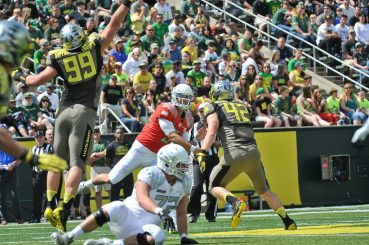Mike Merrell’s Three-and-Out
No doubt about it. Oregon football 2016 is a mess.
Whether it’s football or anything else in life, there’s a point where you’re better off to just call it hopeless and start over. Unfortunately, many see Oregon football as being at that point. The good news is that these “many” with their pitchforks and torches aren’t the ones making the decisions.
Proposed solutions for dumping Mark Helfrich run from the ludicrous (hiring Lane Kiffin) to the desperate (Nick Allioti, and while you’re at it, replace athletic director Mullens with Mike Bellotti). And there are those who would like to bring in an up-and-coming head coach such as Houston’s Tom Herman to use Oregon as a stepping stone as Chip Kelly did.
I am skeptical that Kiffin, Allioti or an up-and-comer is either necessary, or would be a particularly smart decision.

The Ducks were plenty motivated against Florida State in the Rose Bowl — and it wasn’t because of the great Chip Kelly pep talk two years before.
What’s missing in proposals to move on from Helfrich is anything that vaguely resembles precise focus on the Ducks’ problems. It’s a case of, “If a team’s not winning, it’s on the head coach. Can him, and everything will be good again.”
Sometimes amputation is the only viable option. But who would want to go to a doctor who thought of it as the first option? Most of us want doctors who look at our problems with more precise thinking than that.
Before fans jump into the Great Oregon Helfrich Witch Hunt, I would like to ask them to look at this with the same precision that they hope their doctors would use in treating a medical problem. And that is the subject of this edition of the Three-and-Out.
1. What’s not broken? While Oregon’s offensive production is not quite where it has been in recent years, there is absolutely nothing that calls for amputation. Even in a rebuilding year fraught with injuries, the Ducks are still No. 20 nationally in offensive production per game.
Helfrich has accomplished this despite:
• Having to use six different quarterbacks over the past three years
• Replacing a Heisman-winning quarterback
• Having an offensive coordinator in his first year at the position
• Dealing with enough injuries to open an emergency ward
• Starting four freshmen on the offensive line
• Getting zero support from a defense that can’t get off the field.

Ill take “What’s not broken” for $400, Alex.
On the offensive side of the ball, I’m not sure what more could be asked of Helfrich, short of walking on water.
So here’s the key question: What do you do with something that is not broken? Perhaps there are those with other ideas, but where I come from, you don’t try to fix it.
2. What is broken? While Oregon’s defense showed some signs of life against California, it remains one of the worst defenses in I-A college football. Oops, I just looked at the ESPN stats, and Oregon is not one of the worst defenses in I-A football. In yards per game allowed, it is THE worst. We’re talking No. 128 out of 128, here.
The big question is, “Why?”
There are a few stock excuses. It’s a young defense. Recruiting sanctions from the Willie Lyles case hurt recruiting. Coaches can’t recruit to start with. Injuries. The young guys coming in feeling “entitled” instead of working for it.
But is any of that true? Does any of that get to the root of the problem? I don’t think so.
The root of what is wrong with Oregon football rests in figuring out what is up with the defense’s upperclassmen. I’m defining “upperclassmen” as those players who are going on at least their third year out of high school, so it includes redshirt sophomores.

The defensive recruiting classes of 2012, 2013 and 2014 have failed to step up.
I’m picking on these guys for a couple of reasons. First, they’ve been around long enough that they should have things figured out, if they had the talent to begin with. Second, other than late additions, these guys were with the program the last time the Ducks went to the national championship game. They were on the team that massacred the Seminoles in the Rose Bowl.
When I started looking into this, I suspected that there weren’t very many of these players left on the roster. I was wrong.
There are 14 defensive linemen, seven linebackers and eight defensive backs on the Ducks roster who are listed as redshirt sophomores, or any kind of juniors or seniors. That’s a total of 29 defensive players who are headed around the block for at least the third time. For the most part, their credentials before coming to Oregon, while not totally blue chip, certainly do not provide any sort of explanation for the level they are playing at now.
3. The solution. Forget messing with the offense. Yes, it’s a rebuilding year. But with a stud-to-be freshman quarterback, four freshmen starting on the offensive line, and enough young skill players, this unit will be humming along just fine plenty soon, with absolutely zero change in leadership.
The solution to Oregon’s problems lies in figuring out what is up with the upperclassmen on the defensive side of the ball. And then fixing it.
Can the present defensive coaches do that? I’m not one to know.
The teaching/learning continuum is a funny thing. In order to work, it takes good teachers and it takes good learners. And the teachers have to be teaching the right subject. Something here hasn’t worked for the Ducks.
There are a number of possibilities. Maybe, while Oregon led the nation in offensive innovation, other teams were focused on figuring out how to stop the innovation and got a few years jump on the Ducks defensively.
Maybe enough of Oregon’s defensive players who have been around have decided they’ve seen their best days for football. The NFL ain’t happenin’, so what the hell. Time for books and skirts.
Maybe this particular group of players are just slow learners.
Maybe the Ducks defensive coaches are just at that point in life where they need to find something different to do. It happens in all professions.
Maybe schemes and techniques being taught are dated or ill-conceived.
Maybe Oregon’s defense has been suspect for years, and it has finally reached the point where it can no longer be ignored.
Maybe it’s a perfect storm of injuries and players and coaches who have their glory years in the rearview mirror. To be the best or worst at anything usually takes a fairly complete package.
I have no way of knowing. That’s Helfrich’s job. But I can say with little doubt that once he gets it figured out and fixed, the Ducks will be on the mend.
It has taken a couple of band aids for Helfrich to meet Oregon’s offensive challenges, but he’s pulled it off. Kudos to Helfrich and the offensive assistants for keeping the train going against all odds.
The defense, on the other hand, is a complete bust. In the past three games, the Ducks are just 31 yards shy of giving up 2,000 yards. That’s a solid mile, and from the couch to the fridge short of being another eighth of a mile on top of it. And they have forced zero turnovers.
Again, there are 29 defensive players on the Ducks roster who are in at least their third year out of high school. Virtually all of these players were considered to have FBS college potential. Something has gone terribly wrong with this group. And the risk is that if the problems are not identified and dealt with, the next generation could end up in the same spot.
But for those who don’t know, Mark Helfrich is a smart dude, and he has demonstrated that he is not afraid to make hard decisions. He’ll figure it out.
Mike Merrell
Sandpoint, Idaho
Top phto by John Strobeck
Disclaimer: Readers: Every writer on FishDuck.com is allowed to express their opinion in their articles. However, articles do not represent the views of the other writers, editors, coaching consultants, management, or the principals of FishDuck.com. Charles Fischer
Related Articles:
Mike (Editor-in-Chief) is a 1970 graduate of the University of Oregon where he attended the Honors College and received all-conference honors as a swimmer. After college, Mike ran for the Oregon Track Club and narrowly missed qualifying for the US Olympic Trials in the marathon. He continues his involvement in sports with near-daily swimming or running workouts, occasional masters swim competition (where he has received two Top-10 World rankings), providing volunteer coaching to local triathletes and helping out with FishDuck.com.
Mike lives on 28 acres in the forest near Sandpoint, Idaho, where he has served as a certified public accountant for most of his working career. His current night job is writing novels about Abby Westminster, the only known illegitimate daughter of Britain’s finest secret agent who has to bring down arch-villains plotting dastardly deeds. And, yes, Abby is also a DUCK!

